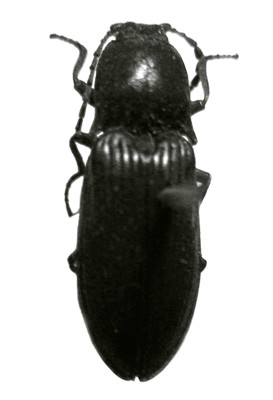Pests
Selatosomus spretus Mannh. . Siberian Click Beetle
Systematic position.
Class Insecta, order Coleoptera, family Elateridae, subfamily Lepturoidinae, tribe Corymbitini, genus Selatosomus.Biological group:
Polyphagous pests.Morphology and biology.
Beetle is black or dark brown, with metallic shine; it is 7-11 mm long and 2 mm wide. The body of the beetle is rather convex; elytra are glabrous. Pronotum is longer than wide. Eggs are white, nearly globe-shaped, 0.5 mm in diameter. Larva is light yellow, with metallic shine; it is 22 mm long and 2 mm wide. The last segment of larval body is nearly rectangular and non-pointed at apex. Pupa is white, 8-12 mm long. The larvae in all the species of Elateridae are hard, nearly cylindrical and shining. They are called "wireworms" because they look like a wire fragment. S. spretus has 4-5-year generation development. Beetles fly and reproduce from May to July. They lay eggs only after additional feeding by leaf parenchyma of various plants. Females lay eggs on soil surface or into soil fissures. The female total productivity is 150 eggs. The eggs, larvae, and pupae develop in soil. The larvae develop during 3-4 years, depending on a climatic zone. During this period, they molt 8-11 times and winter to a depth of 20-50 cm. The adult larvae pupate in July-August. The young imagoes emerge in July-August and stay wintering in soil on a depth of 10-15 cm.Distribution.
S. spretus is spread in the southern part of Siberia from the Southern Ural to Yakutsk and the Russian Far East, and in Northern Mongolia. The zone of its highest density and harmfulness includes the forest-steppe foothill districts with alkaline chernozem-like meadow soils in the Altai and Krasnoyarsk Territories, Tyva and Khakassia Republics, Novosibirsk and Kemerovo Regions. In these territories, the species occurs on the southern mountainsides up to 1000 m above sea level, where it spreads to the mountain-forest zone.Ecology.
S. spretus is the omnivorous, mainly phytophagous species. Its females have cryptic mode of life in shaded places; they are active in twilight. Males live openly; they are active at day time, occurring on various grass plants and in orchards. The pairing of imagoes occurs on soil surface. The females lay eggs in arable lands, mainly in grain cereals or perennial grass plantations. Eggs develop 20-30 days, and pupae develop 14-20 days under the soil temperature 18-23°C. The thermal limits for feeding and development of larvae are 10 to 35°C. The larvae actively move in soil, seeking food or places with optimal thermal and humidity conditions. Natural enemies of all elaterid beetles are ground-beetles of the genera Carabus, Calosoma, Harpalus, Amara (Coleoptera, Carabidae), more than 200 species of birds, and also moles, toads, and lizards. They eat many beetles and larvae on fields after spring and autumn plowings.Economic significance.
The larvae (wireworms) are only harmful in S. spretus and other phytophagous beetles of the family Elateridae. They eat seeds, seedlings, and underground parts of various agricultural crops (including perennial crops) and weeds. S. spretus are the most harmful for the field crops, such as grain cereals, potato, cabbage, carrot, beet, etc. Their harmfulness consists in causing shoot thinning, depression of damaged plants, and deterioration of commercial quality of potato tubers, beet and carrot. The economical threshold of wireworm numbers in major crops (maize, potato, sugar beet) is 3 to 15 larvae per 1 sq. m. The real density of S. spretus larvae populations is often repeatedly more than this level in forest-steppe zone of Siberia. Preventive and protective measures are the extermination of weeds, especially the couch-grass; deep subsurface tillage of fallow fields; cultivation and interrow treatment of soil on tilled crop plantations in spring and in early summer; early post-harvest autumn plowing of soil; extermination of crop plant residues; application of organic fertilizers in high doses; application of soil insecticides in spring before sowing, if the wireworm population density is higher than economical threshold for the crop.Reference citations:
Anon. 2005. Economical Threshold Levels of main pests of agricultural crops. Plant Protection and Quarantine. 10: 36-38; 11: 40-43. (In Russian)Bobinskaya S.G., Grigorjeva T.G., Persin S.A. 1965. The wireworms and control measures against them. Leningrad: Kolos. 223 pp. (In Russian)
Chenkin A.F., Grivanov K.P., eds. 1974. Reference Book for plant protection. Moscow: Rosselkhozizdat. 400 pp. (In Russian)
Cherepanov A.I. 1957. Click beetles of Western Siberia (Coleoptera, Elateridae). Novosibirsk: Novosibirsk Publishing House, 382 p. (In Russian).
Cherepanov A.I. 1965. Wireworms of Western Siberia. Мoscow: Nauka, 190 pp. (In Russian)
Gurjeva E.L. 1972. The Insects of Mongolia. Vol. I. Leningrad. 464 pp. (In Russian)
Kryzhanovsky O.L., ed. 1974. Beetles. Insects and mites . the pests of agricultural crops. Vol. II. Leningrad: Nauka. 336 pp. (In Russian)
Pavlov I.F. 1987. Protection of field crops from pests. Moscow: Rosselkhozizdat. 256 pp. (In Russian)
Shchegolev V.N., ed. 1955. Glossary-reference Book for Entomologist. Moscow & Leningrad: State Publ. Agricult. Liter., 451 pp. (in Russian).


